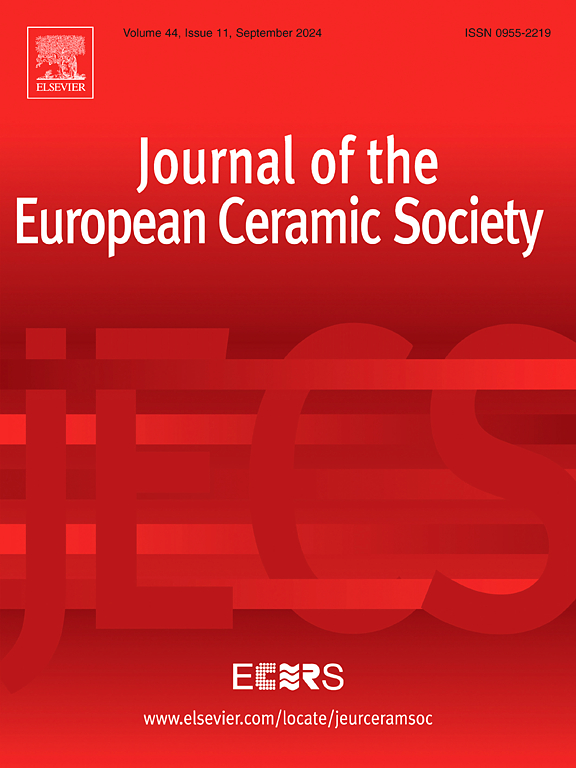The oxidation resistance and plasma ablation performance at 3000 K of HfC-TiC ultra-high temperature ceramics
IF 6.2
2区 材料科学
Q1 MATERIALS SCIENCE, CERAMICS
Journal of The European Ceramic Society
Pub Date : 2025-05-13
DOI:10.1016/j.jeurceramsoc.2025.117530
引用次数: 0
Abstract
Ultra-high-temperature ceramics (UHTCs), owing to their exceptional performance under extreme heat and harsh conditions, have become the preferred choice for critical thermal protection materials in high-speed aerospace vehicles. Here, the HfC-TiC ceramics were fabricated through pressureless sintering, and its oxidation behaivor was investigated using non-isothermal method. The oxidation activation energy of HfC-TiC sample reaches 385.39 kJ/mol. Then the ablation behavior of HfC-TiC ceramics was tested under plasma ablation conditions (3000 K, 5.0 MW/m2). The mass ablation rate and linear ablation rate of HfC-TiC can reach −1.11 × 10−3 g·s−1 and −1.40 × 10−3 mm·s−1 after being ablated for 300 seconds, respectively. The oxide layers in the center consisted of a porous oxide upper layer, a dense Ti-enriched intermediate layer, and an oxide inner layer. This complex multi-layered oxidative configuration synergistically protected the underlying carbide matrix, significantly enhancing the ablation resistance of HfC-TiC ceramics.
HfC-TiC超高温陶瓷在3000 K下的抗氧化性能和等离子烧蚀性能
超高温陶瓷(UHTCs)由于其在极端高温和恶劣条件下的优异性能,已成为高速航空航天飞行器中关键热防护材料的首选。本文采用无压烧结法制备了HfC-TiC陶瓷,并用非等温法研究了其氧化行为。HfC-TiC样品的氧化活化能达到385.39 kJ/mol。然后测试了HfC-TiC陶瓷在3000 K, 5.0 MW/m2等离子体烧蚀条件下的烧蚀行为。HfC-TiC经300 s烧蚀后的质量烧蚀率为- 1.11 × 10−3 g·s−1,线性烧蚀率为- 1.40 × 10−3 mm·s−1。中间的氧化层由多孔的氧化物上层、致密的富钛中间层和氧化内层组成。这种复杂的多层氧化结构协同保护了底层碳化物基体,显著提高了HfC-TiC陶瓷的抗烧蚀性。
本文章由计算机程序翻译,如有差异,请以英文原文为准。
求助全文
约1分钟内获得全文
求助全文
来源期刊

Journal of The European Ceramic Society
工程技术-材料科学:硅酸盐
CiteScore
10.70
自引率
12.30%
发文量
863
审稿时长
35 days
期刊介绍:
The Journal of the European Ceramic Society publishes the results of original research and reviews relating to ceramic materials. Papers of either an experimental or theoretical character will be welcomed on a fully international basis. The emphasis is on novel generic science concerning the relationships between processing, microstructure and properties of polycrystalline ceramics consolidated at high temperature. Papers may relate to any of the conventional categories of ceramic: structural, functional, traditional or composite. The central objective is to sustain a high standard of research quality by means of appropriate reviewing procedures.
 求助内容:
求助内容: 应助结果提醒方式:
应助结果提醒方式:


